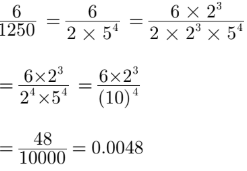VSAQ for Chapter 1 Real Numbers Class 10 Math NCERT
Important Questions1
What is the HCF of smallest primer number and the smallest composite number?
Answer
Smallest prime number is 2 and smallest composite number is 4. HCF of 2 and 4 is 2.
VSAQ
2
Write one rational and one irrational number lying between 0.25 and 0.32.
Answer
Given numbers are 0.25 and 0.32.Clearly,
Thus 0.30 is a rational number lying between 0.25 and 0.32. Also 0.280280028000. …. has non–terminating non–repeating decimal expansion. It is an irrational number lying between 0.25 and 0.32.
VSAQ
3
If HCF(336, 54) = 6, find LCM(336, 54).
Answer
HCF × LCM = Product of number6 × LCM = 336 × 54
Thus LCM of 336 and 54 is 3024.
VSAQ
4
Explain why 13233343563715 is a composite number?
Answer
The number 13233343563715 ends in 5. Hence it is a multiple of 5. Therefore it is a composite number.
VSAQ
5
a and b are two positive integers such that the least prime factor of a is 3 and the least prime factor of b is 5. Then calculate the least prime factor of (a + b).
Answer
Here a and b are two positive integers such that the least prime factor of a is 3 and the least prime factor of b is 5. The least prime factor of (a + b) would be 2.
VSAQ
6
What is the HCF of the smallest composite number and the smallest prime number?
Answer
The smallest prime number is 2 and the smallest composite number is 4 = 22.Hence, required HCF is (22, 2) = 2.
VSAQ
7
Calculate the HCF of 33 × 5 and 32 × 52 .
Answer
We have 33 × 5 = 32 × 5 × 332 × 52 = 32 × 5 × 5
HCF(33 × 5, 32 × 52) = 32 × 5
= 9 × 5 = 45
VSAQ
8
If HCF (a, b) = 12 and a × b = 1800, then find LCM (a, b).
Answer
We know thatHCF(a, b) × LCM(a, b) = a × b
Substituting the values we have
12 × LCM(a, b) = 1800
or,
VSAQ
9
What is the condition for the decimal expansion of a rational number to terminate? Explain with the help of an example.
Answer
The decimal expansion of a rational number terminates, if the denominator of rational number can be expressed as 2m5n where m and n are non negative integers and p and q both co–primes.e.g.
VSAQ
10
Find the smallest positive rational number by which 1/7 should be multiplied so that its decimal expansion terminates after 2 places of decimal.
Answer
Thus smallest rational number is 7/100
VSAQ
11
What type of decimal expansion does a rational number has? How can you distinguish it from decimal expansion of irrational numbers?
Answer
A rational number has its decimal expansion either terminating or non–terminating, repeating An irrational numbers has its decimal expansion non–repeating and non–terminating.
VSAQ
12
Calculate 3/8 in the decimal form.
Answer
We have
VSAQ
13
The decimal representation of 6/1250 will terminate after how many places of decimal?
Answer
We have
VSAQ
14
Find the least number that is divisible by all numbers between 1 and 10 (both inclusive).
Answer
The required number is the LCM of 1, 2, 3, 4, 5, 6, 7, 8, 9, 10,LCM = 2 × 2 × 3 × 2 × 3 × 5 × 7
= 2520
VSAQ
15
Write whether rational number 7/75 will have terminating decimal expansion or a non–terminating decimal.
Answer
We haveSince denominator of given rational number is not of form 2m × 5n , Hence, It is non–terminating decimal expansion.
VSAQ